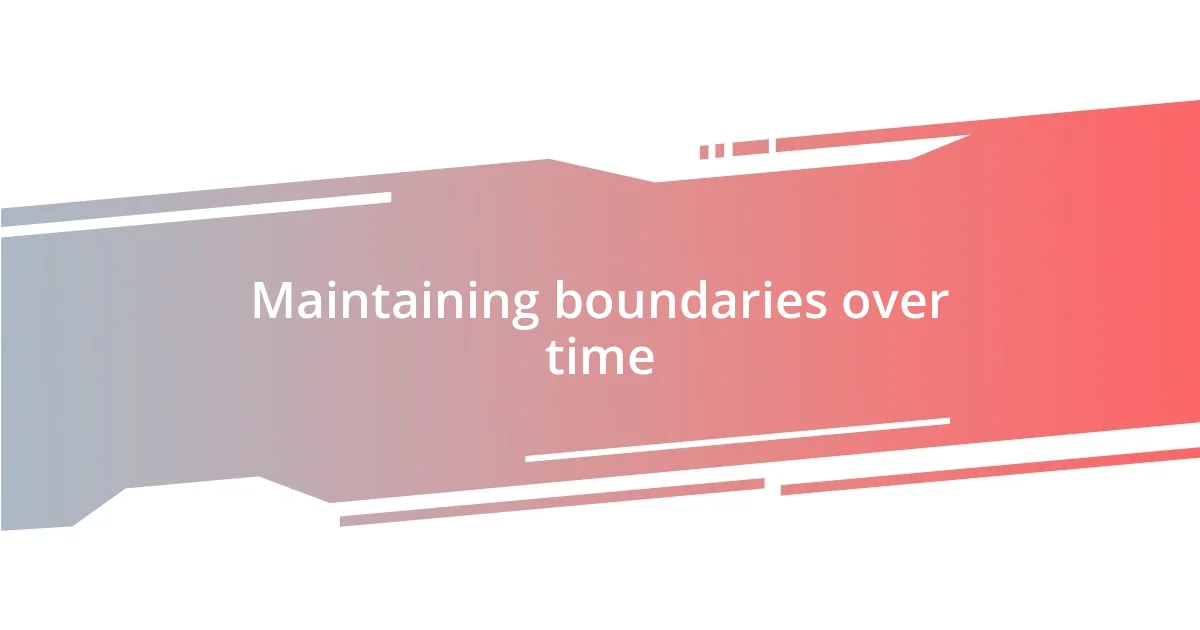Key takeaways:
- Understanding and recognizing personal boundaries is essential for healthy relationships and self-respect, requiring self-awareness and clarity in expressing one’s limits.
- Effective communication of boundaries involves using “I” statements, being specific, and maintaining a respectful tone to ensure clear understanding and reduce defensiveness.
- Maintaining boundaries over time necessitates continuous reflection, flexibility to adapt to changes, and sharing experiences with others to foster accountability and support.

Understanding personal boundaries
Understanding personal boundaries is crucial for maintaining healthy relationships and fostering self-respect. I remember when I first learned about boundaries during a particularly overwhelming time in my life. I was constantly saying “yes” to others, often feeling drained and underappreciated. Have you ever felt that way too? It’s a wake-up call when you realize that your comfort matters just as much as everyone else’s needs.
Personal boundaries are like a protective fence for your emotional and mental space. They help delineate where you end and others begin, ensuring that your feelings and preferences are honored. Think about a time when you let someone cross one of your boundaries. How did that impact you? Personally, it took a while for me to understand that it’s perfectly acceptable to assert my limits, whether it’s in friendships or at work.
Recognizing your own boundaries starts with self-awareness. I found it helpful to reflect on my values and what truly makes me comfortable. What are the situations where you often feel uneasy? By identifying these moments, we can better articulate our boundaries and communicate them effectively. Isn’t it empowering to know that setting boundaries is an act of self-care, paving the way for more fulfilling connections?

Recognizing boundary violations
Recognizing boundary violations can be challenging but is essential for protecting our well-being. There have been times in my life when I overlooked small signs, like feeling uncomfortable with how someone spoke to me or how often they demanded my time. I remember a friend who would often drop by unannounced, and while I enjoyed their company, it began to feel intrusive. It became a pattern that I realized I needed to address. Being attuned to these discomforts is key to identifying when boundaries are being crossed.
Here are some common signs of boundary violations to watch for:
- Feeling drained or overwhelmed after interactions with someone
- Frequent feelings of resentment or frustration
- Physical discomfort or tension during conversations
- Others disregard your needs or requests
- Less time for self-care due to demands from others
- Repeatedly saying “yes” when you want to say “no”
By recognizing these signs, I’ve learned to trust my instincts and voice my feelings before it builds up into something larger. It’s a liberating practice that allows for healthier and more balanced relationships.

Communicating your boundaries clearly
When it comes to communicating boundaries, clarity is key. I remember an instance where I had to tell a colleague not to interrupt me during meetings. Initially, I was hesitant, fearing it might hurt our working relationship. But when I finally articulated my need for uninterrupted speaking time, it created a respectful dynamic that boosted our collaboration. Have you faced a situation where you hesitated to voice your boundaries? In my experience, the moment I shared my expectation openly, it alleviated so much tension.
It’s important to be assertive yet respectful when expressing your boundaries. Using “I” statements, like saying, “I feel overwhelmed when I’m not given personal time,” helps to frame your feelings without putting others on the defensive. For instance, I often remind myself that expressing my needs isn’t a personal attack; it’s simply a way to safeguard my emotional well-being. How often do we think our needs are too trivial to mention? Trust me, they’re not.
Being specific about your boundaries leaves no room for misinterpretation. Instead of saying, “I need some space,” try stating, “I need a couple of hours to recharge alone after work.” When I started articulating my boundaries like that, I realized how much better people responded. They appreciated the clarity and felt more equipped to respect my space. Don’t underestimate the power of straightforward communication – it’s the bridge to healthier relationships.
| Effective Communication | Ineffective Communication |
|---|---|
| Using “I” statements | Blaming others or generalizing |
| Being specific | Being vague |
| Maintaining a respectful tone | Using aggressive language |
| Being assertive | Being passive or dismissive |

Using assertive body language
Using assertive body language is crucial when establishing boundaries. I recall a time when I had to confront a family member about their constant interruptions during our conversations. As I took a deep breath and squared my shoulders, I noticed my body instinctively matched the assertiveness of my words. Standing tall not only made me feel stronger but also conveyed my seriousness; it was like setting an invisible barrier that clearly communicated, “This is my space.”
The way we physically present ourselves can greatly influence how our boundaries are perceived. I learned that maintaining eye contact can exhibit confidence and sincerity. When I met my friend’s gaze while discussing my need for time alone, it was as if the words became more impactful. Have you ever noticed how people shift their focus when they see you are engaged and present? It’s not just about what you say; it’s about what your body is saying, too.
Moreover, I began to understand that a calm demeanor is essential. In moments of tension, I’d consciously relax my hands instead of letting them ball into fists, signaling to both myself and others that I wasn’t here to engage in conflict. One time, while addressing a situation with an assertive colleague, I focused on open body language, with uncrossed arms and an approachable posture. The shift in dynamic was immediate. It made dialogue easier and reduced defensive reactions. Isn’t it fascinating how asserting yourself physically can lead to more open interactions?

Handling pushback and resistance
Handling pushback and resistance can be one of the most challenging parts of setting boundaries. I remember a conversation with a close friend who initially resisted my need for solitude. They didn’t understand why I needed to take some time for myself and pushed back, suggesting that I was being anti-social. In that moment, I realized that not everyone would initially understand my needs, and it felt frustrating. How can we expect others to respect our boundaries if we don’t take the time to explain why they matter to us?
When I faced resistance, I found that staying calm was essential. I had a moment when I raised my voice slightly while trying to explain my point during a disagreement, only to see my friend withdraw even more. I took a moment, took a deep breath, and approached the conversation again, this time with an open mind. Isn’t it interesting how just a slight shift in emotional tone can either engage or alienate someone? Once I softened my approach and really listened to their concerns, it opened the door for a genuine dialogue.
It’s sometimes helpful to reframe resistance as a conversation starter rather than a roadblock. One time, a coworker reacted defensively when I laid out my boundaries regarding project responsibilities. Instead of getting frustrated, I asked them how they felt about the expectations I set. What followed was a collaborative discussion that resulted in a compromise. This experience taught me that addressing pushback can lead to deeper understanding, transforming potential conflict into an opportunity for connection. How often do we miss these chances because we view resistance as a negative force rather than a catalyst for growth?

Practicing self-care and reflection
Practicing self-care and reflection is an integral part of maintaining healthy boundaries. I vividly recall a weekend when I decided to indulge in a solitary retreat to clear my mind. After setting my phone aside and immersing myself in a good book, I realized how rejuvenating it felt to focus on myself. Have you ever noticed how a little time alone can provide clarity and spark self-awareness?
Taking time for reflection has also helped me assess my boundaries more effectively. After a heated discussion with a team member about workload expectations, I made it a point to sit down and evaluate my reaction. Jotting down my feelings in a journal shed light on my motivations and limitations, which empowered me to articulate my needs better. I often ask myself, “What am I truly comfortable with?” This simple question opens a doorway to deeper understanding.
Additionally, my self-care routine isn’t just about relaxation—it incorporates activities that foster growth. For instance, I took up meditation, and let me tell you, it was challenging at first. Yet, with practice, I found it invaluable for maintaining my emotional balance. Each session allows me to reflect not just on my boundaries, but also on the emotions that arise when I enforce them. Isn’t it amazing how a few moments of mindfulness can transform your perspective on conflict and self-worth?

Maintaining boundaries over time
Maintaining boundaries over time requires consistent reflection on their importance and effectiveness in my life. Not long ago, I found myself feeling overwhelmed when a family member started to encroach upon my personal space once more. It struck me that I hadn’t reiterated my boundaries clearly for a while. Have you ever noticed that boundaries can blur if we don’t reaffirm them? I decided to have that chat again, and it made a big difference.
I also realized that flexibility plays a critical role in maintaining boundaries. For example, when I started working from home, my previously established boundaries began to shift. I had to navigate the challenge of separating work time from personal time in an environment that blurred both worlds. This taught me the importance of reevaluating and adjusting my boundaries periodically. How do you adapt yours to life’s changes?
Finally, I’ve found that sharing my boundary experiences with friends fosters accountability. One time, I joined a support group where we discussed our struggles with boundaries. Sharing stories made me feel less isolated and encouraged me to stay true to my commitments. It’s fascinating how strengthening these connections can reinforce my resolve. Have you experienced this kind of mutual support in your life? I believe it’s a vital aspect of effectively maintaining boundaries over time.















